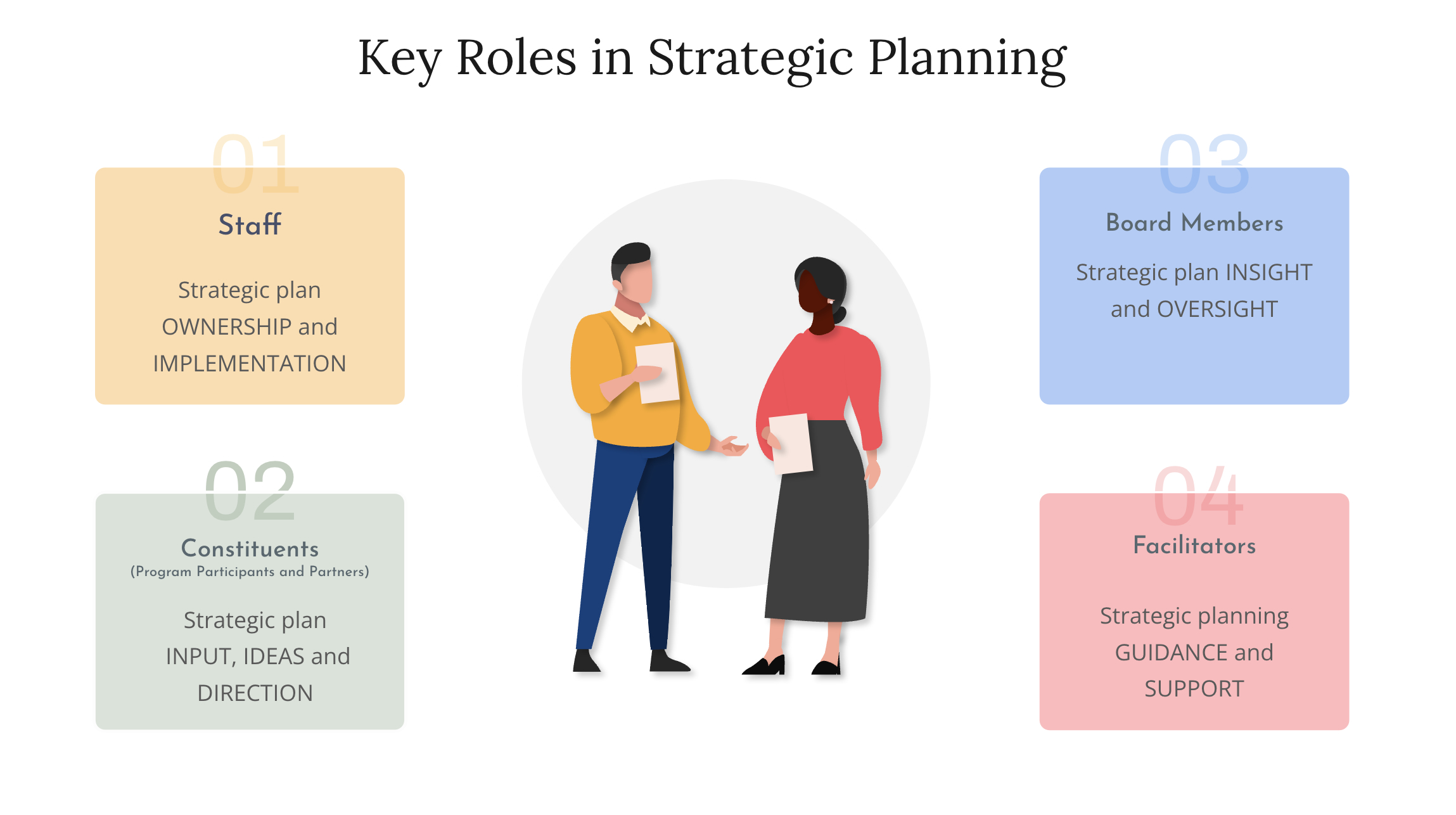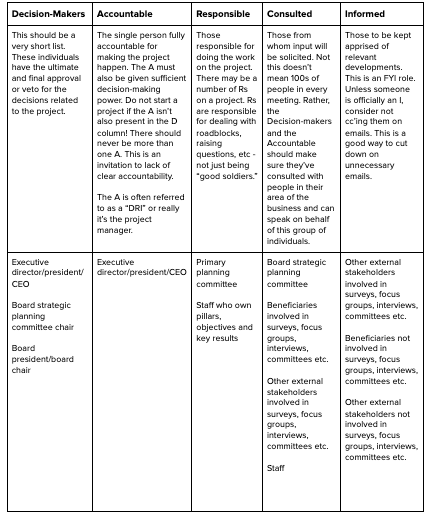Involving the right people, in the right ways, at the right times, is the most difficult part of the strategic planning process for most nonprofits.
We wrote extensively about the role your board should play in strategic planning here. But your board is just one of many groups of stakeholders your organization must engage, and I’d argue that it’s not even the most important one.
There are four groups that must be involved in strategic planning, including:
-
Staff
-
Constituents (the people who use your programs or services, and other external stakeholders such as partners, volunteers, and donors)
-
Board
-
Facilitators
Each of these groups should play a unique role in the process, and those roles need to be spelled out early and often. If they’re not, organizations tend to face unnecessary friction in the strategic planning process that keeps them from arriving efficiently at a clear set of pillars (aka priorities), objectives, and key results for their strategic plan. The board tries to take on what should really be the work of the staff, or the staff misplaces their expectations on the consultants, rather than on one another, or worst of all, constituents are left out of the process, their priorities unheard. We’ve seen this happen too many times, and when it happens, no one wins.
That’s why we’re dedicating this post to clearly defining the four essential roles that must be present in every effective strategic planning process. If you want the tl;dr. this graphic breaks it down.

Staff
Role: Strategic plan ownership and implementation
Staff play the most hands-on role in strategic planning. They should act as the primary developers of both the “big picture” elements of your strategic plan (mission, vision, pillars etc.) and the nitty gritty elements that guide day-to-day work, such as objectives, key results and activity plans. Staff are also responsible for implementing the strategic plan once it is finalized, and measuring their progress. Among staff, there are typically a few sub-roles that warrant further discussion. These include:
- Executive director/president/CEO: The person in this role is typically the one held ultimately accountable for the contents of your final strategic plan, and for making it happen. They are present in every strategic planning session.
- Leadership team or key staff: We suggest that organizations form what we call a primary planning committee made up of 5-8 members of their leadership team, or other key staff who will play an integral role in strategic planning. These individuals are present in all or most of the strategic planning sessions, and are part of every step of the strategic planning process, from working on the mission and vision to setting objectives, key results and activity plans.
- Other staff: Staff who are not included in the primary planning committee should still be involved in the strategic planning process through surveys, listening sessions and opportunities to provide feedback on parts of the plan at various different stages of development. In some cases, you may also find that your primary planning committee ends up choosing objectives for its strategic plan that require input from staff outside the committee in order to be fully fleshed out. When this happens, it can make sense to involve other staff members in key result development and activity planning as it relates to their areas of focus or expertise.
Why is this the appropriate role for staff? It comes down to the fact that staff have the most intimate insight into and influence over the day-to-day realities of your organization, and therefore are in the best position to develop and actualize the detailed elements of its strategic plan.
Constituents
Role: Strategic plan input and ideas
If you’re familiar with our Shared Power StrategyTM philosophy, you already know we believe that constituents are the most important, and most often overlooked group in the nonprofit strategic planning process. Your organization’s primary constituents (the people who use your programs or services or stand to benefit from your work) are the reason your organization exists, and their priorities should be the true drivers behind your organization’s strategy, just as customers are the true drivers behind the strategy of a for-profit company. Constituents should be asked to share their priorities, and how your organization can better align with them, at the onset of the strategic planning process, through surveys, interviews, focus groups, candid conversations, or a combination of those approaches. They should also be asked to provide input on your strategic plan pillars as you are shaping them. Only your constituents can say whether your priorities align with theirs. In some cases, your constituents should also be asked to weigh in on other elements of your full strategic plan. While it is not always possible, in the best-case scenario, you’ll form a constituent committee that will be intimately involved in the strategic planning process, attending at least part of your strategic planning retreat and providing insights and input at several points along the way. Ultimately, it should be the priorities of your constituents, paired with the expertise of your staff and board, that drives the focus of your strategic plan.
While we’re primarily focused on involving the people who use your nonprofit’s programs and services in the strategic planning process, depending on your goals and strategic challenges, you might also look to bring other external stakeholders into strategic planning. For example, it might make sense to involve your partners, donors, volunteers or even funders in the strategic planning process. Often, we form strategic planning committees made up of a combination of people who use a nonprofit’s programs and services, partners, donors and other external stakeholders, staff, and board members. These groups can all learn valuable lessons from one another, especially when they sit side-by-side in a planning retreat.
Board
Role: Strategic plan insight and oversight
As we discussed in detail in this post, the board has a responsibility to set the strategic direction for your organization, but that doesn’t mean they should be involved in the more detailed, “day-to-day” elements of strategic planning. Instead, board members should collaborate on the “high-level” elements of your strategic plan, and put their stamp of approval on the final plan, once it is complete. Board members bring important expertise and experience to the table that make them valuable advisors on the strategic direction of your organization. However, they are typically not deeply tuned into the day-to-day details of running your nonprofit, nor are they as connected to your nonprofit’s constituents as its staff. That’s why they should provide oversight for the strategic plan rather than getting too deep “in the weeds.”
In the most effective strategic planning processes, there is a strategic planning sub-committee of the board that:
- Participates in sessions to set or reaffirm the organization’s mission and vision
- Learns about the strategic plan pillars recommended by the primary planning committee and collaborates with staff to refine those pillars (and sometimes accompanying objectives, depending on how “hands on” the board is)
- Reviews and helps refine the written strategic plan
- Socializes and champions the strategic plan with other board members
- Helps the executive director/president/CEO present elements of the strategic plan to the full board and secure the board’s final stamp of approval
- Leans on the perspectives and priorities of constituents to inform the organization’s strategic focus
Facilitators
Role: Strategic plan guidance and support
The most effective strategic plans are developed with the support of a consultant or group of consultants that act as facilitators, or guides to the strategic planning process. Their role is not to figure out what your organization’s mission, vision, strategic plan pillars or objectives should be. It is to effectively shepherd your organization through the process of figuring that out for itself, while thoughtfully involving all the other stakeholders mentioned previously. Effective facilitators or consultants can conduct research to inform your strategic plan and engage your stakeholders in the process, schedule and lead meetings/planning sessions, counsel you through challenging decisions, help build consensus, produce documentation of the choices made in strategic planning sessions, and even write your strategic plan, but they’re not ultimately the ones responsible for its contents. That’s squarely the responsibility of your staff, with sign-off from the board. Still, effective facilitators can make or break a strategic planning process. Make sure whomever you choose to work with has a well-defined, inclusive process proven to produce an actionable and measurable strategic plan.
Strategic Planning Roles and the DARCI Framework
Let’s take a look at how these roles might stack up against the DARCI Framework for decision making, which we use frequently in our work.
Next time you’re beginning a strategic planning process, I hope you’ll reflect carefully on who you’re planning to involve, and ensure each of these four roles is filled, with little to no overlap. And if you’re in one of these groups, keep this post in mind in order to help you stay in your lane and ensure an inclusive, effective planning process.
